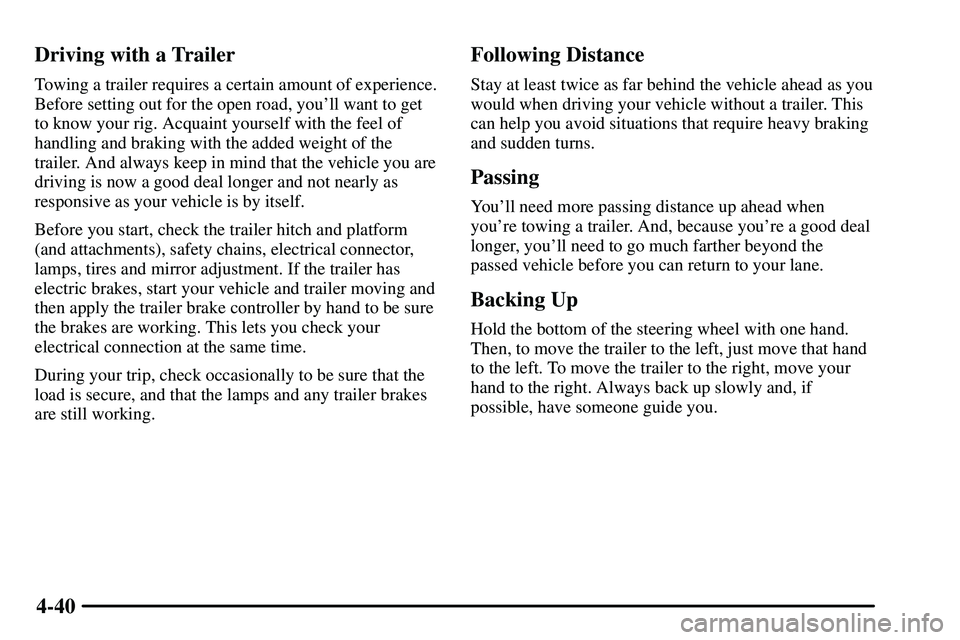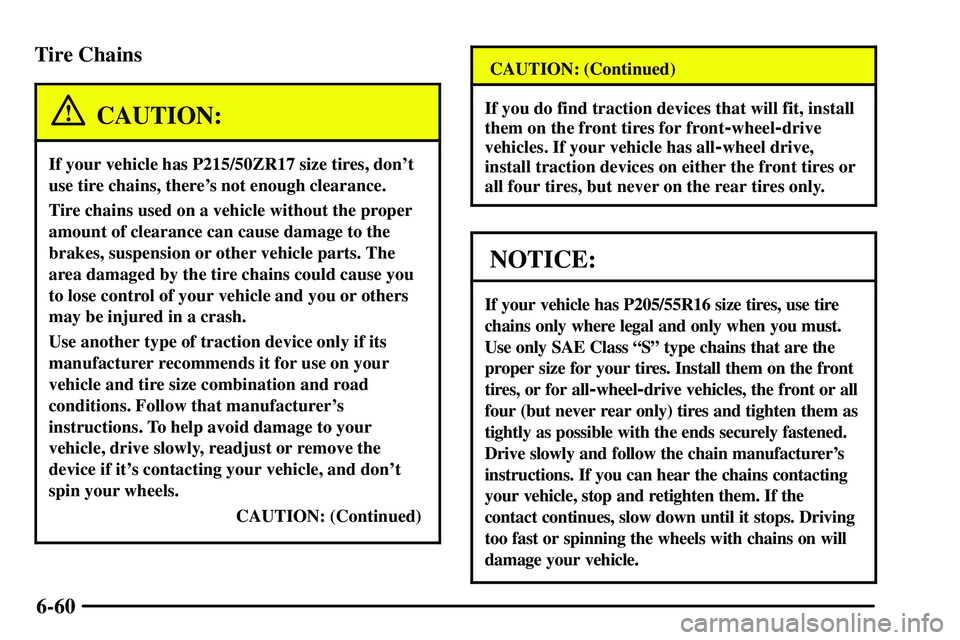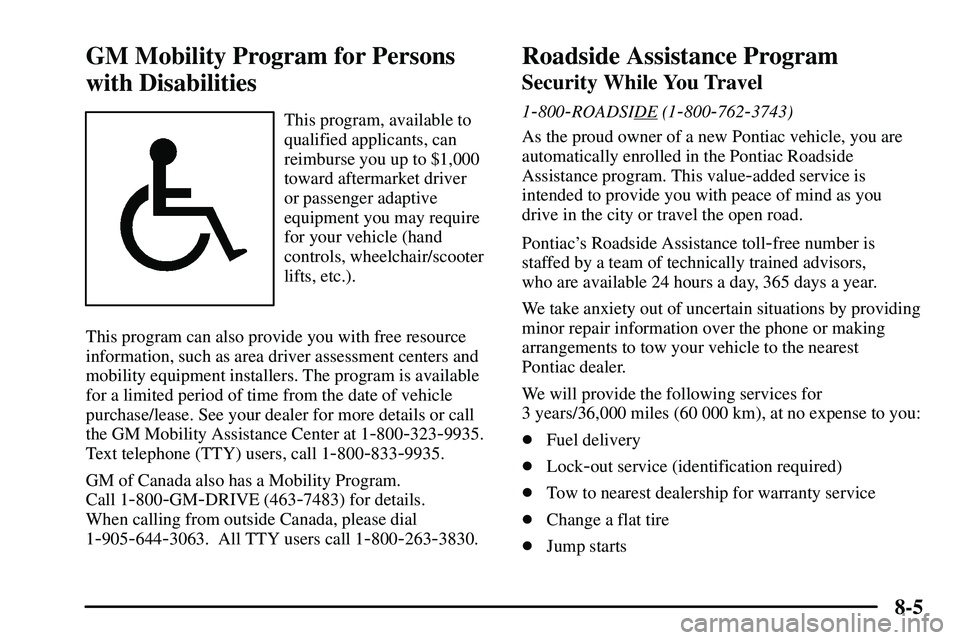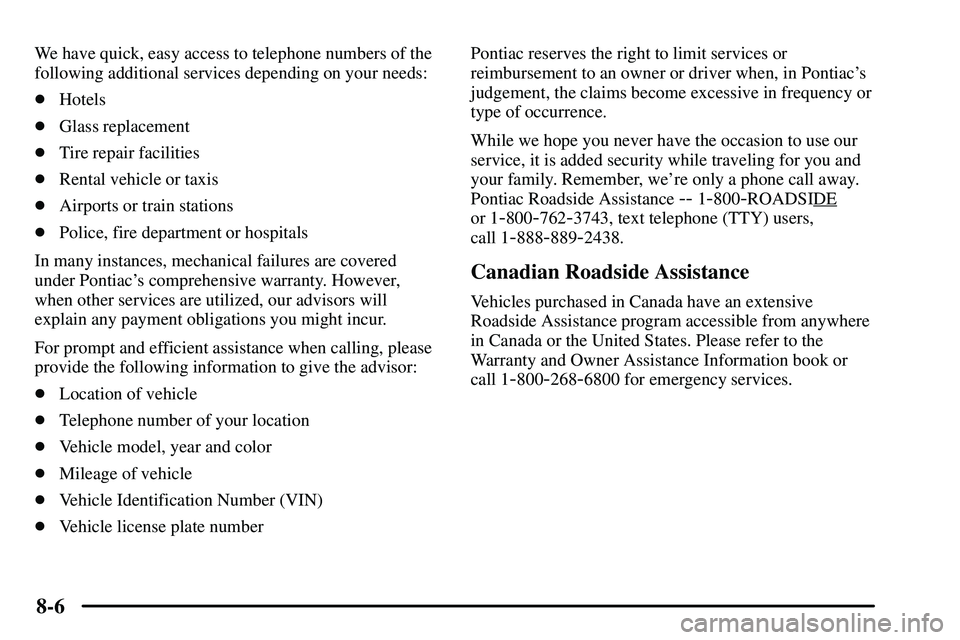Page 208 of 381

4-40 Driving with a Trailer
Towing a trailer requires a certain amount of experience.
Before setting out for the open road, you'll want to get
to know your rig. Acquaint yourself with the feel of
handling and braking with the added weight of the
trailer. And always keep in mind that the vehicle you are
driving is now a good deal longer and not nearly as
responsive as your vehicle is by itself.
Before you start, check the trailer hitch and platform
(and attachments), safety chains, electrical connector,
lamps, tires and mirror adjustment. If the trailer has
electric brakes, start your vehicle and trailer moving and
then apply the trailer brake controller by hand to be sure
the brakes are working. This lets you check your
electrical connection at the same time.
During your trip, check occasionally to be sure that the
load is secure, and that the lamps and any trailer brakes
are still working.
Following Distance
Stay at least twice as far behind the vehicle ahead as you
would when driving your vehicle without a trailer. This
can help you avoid situations that require heavy braking
and sudden turns.
Passing
You'll need more passing distance up ahead when
you're towing a trailer. And, because you're a good deal
longer, you'll need to go much farther beyond the
passed vehicle before you can return to your lane.
Backing Up
Hold the bottom of the steering wheel with one hand.
Then, to move the trailer to the left, just move that hand
to the left. To move the trailer to the right, move your
hand to the right. Always back up slowly and, if
possible, have someone guide you.
Page 239 of 381
5-28 Storing the Flat Tire and Tools
CAUTION:
Storing a jack, a tire or other equipment in the
passenger compartment of the vehicle could
cause injury. In a sudden stop or collision, loose
equipment could strike someone. Store all these
in the proper place.
Return the jack, jack handle and wheel wrench to the
storage area. The compact spare tire storage area is
designed only for the compact spare tire, the standard
tire cannot be stored there.
To store the flat tire do the following:
1. If your vehicle has aluminum wheels, remove the
center wheel cap before storing the flat tire.
2. Place the flat tire on the rear cargo area floor panel
with the outer side of the wheel facing up
3. Use the tire tie
-down belts located under the floor
panel to secure the flat tire.
4. Hook the belts (end closest to the buckle) to the rear,
upper tie
-down hooks.
Page 240 of 381
5-29
5. Pass the belts through the center hole of the wheel.
6. Attach the other end of the belts to the rear, lower
tie
-down hooks.
7. Position the tire edge against the rear center end of
the floor panel. Pull the end of the belts to make sure
the tire is secure.
Page 305 of 381

6-60 Tire Chains
CAUTION:
If your vehicle has P215/50ZR17 size tires, don't
use tire chains, there's not enough clearance.
Tire chains used on a vehicle without the proper
amount of clearance can cause damage to the
brakes, suspension or other vehicle parts. The
area damaged by the tire chains could cause you
to lose control of your vehicle and you or others
may be injured in a crash.
Use another type of traction device only if its
manufacturer recommends it for use on your
vehicle and tire size combination and road
conditions. Follow that manufacturer's
instructions. To help avoid damage to your
vehicle, drive slowly, readjust or remove the
device if it's contacting your vehicle, and don't
spin your wheels.
CAUTION: (Continued)
CAUTION: (Continued)
If you do find traction devices that will fit, install
them on the front tires for front
-wheel-drive
vehicles. If your vehicle has all
-wheel drive,
install traction devices on either the front tires or
all four tires, but never on the rear tires only.
NOTICE:
If your vehicle has P205/55R16 size tires, use tire
chains only where legal and only when you must.
Use only SAE Class ªSº type chains that are the
proper size for your tires. Install them on the front
tires, or for all
-wheel-drive vehicles, the front or all
four (but never rear only) tires and tighten them as
tightly as possible with the ends securely fastened.
Drive slowly and follow the chain manufacturer's
instructions. If you can hear the chains contacting
your vehicle, stop and retighten them. If the
contact continues, slow down until it stops. Driving
too fast or spinning the wheels with chains on will
damage your vehicle.
Page 318 of 381

6-73
Fuse Usage
TAIL Front Parking Lamps, Taillamps,
License Plate Lamps, Instrument
Panel Lights, Engine Control
System
OBD On
-Board Diagnostic System
WIPER Windshield Wipers
AM2 Charging System, Air Bag System,
Starter System, Engine Control
STOP Stop Lamps, CHMSL, Engine
Control System, Anti
-lock Brakes,
Cruise Control
DOOR Power Door Locks, Liftglass Lock
AM1 Cigarette Lighter, Gauge,
ECU
-IG, Wiper, Rear Wiper,
Washer Fuses
ECU
-IG Cruise Control, Anti-Lock Brakes,
Theft Deterrent System,
Automatic Transaxle Control
System, Electric Cooling FanFuse Usage
RR WIPER Rear Window Wiper, Rear
Window Defogger
A/C Air Conditioning
INV Power Outlets
P/POINT Power Outlets
ECU
-B Daytime Running Lamps
CIG Cigarette Lighter, Power Rearview
Mirrors, Power Outlets, Audio
System, Automatic Transaxle
Control System
GAUGE Gauges and Meters, Back
-Up
Lamps, Charging System, Power
Door Locks, Power Windows,
Sunroof, Air Conditioning,
Cruise Control
WASHER Windshield Washers
*1 Engine Control System
Page 320 of 381
6-75
Fuse/Relay Usage
DIMMER Headlamp Dimmer (Relay)
SPARE Spare Fuse
SPARE Spare Fuse
SPARE Spare Fuse
HORN Horn
FAN NO. 2 Cooling Fan System (Relay)
FAN NO. 1 Cooling Fan System (Relay)
ABS NO. 2 Anti
-lock Brake System
RDI FAN Electronic Cooling Fan SystemFuse/Relay Usage
ABS NO. 1 Anti
-lock Brake System
ALT Charging System, DEFOG,
HEATER, GAUGE, ECU
-IG,
WIPER, RR WIP, WASHER, ABS
NO. 1, ABS NO. 2, RDI FAN,
FOG, GAUGE, INV, AM1 Fuses
HEAD RH Right
-hand Headlamp
HEAD LH Left
-hand Headlamp
EFI Electronic Fuel Injection
System (Relay)
FOG Front Fog Lamps
Page 376 of 381

8-5
GM Mobility Program for Persons
with Disabilities
This program, available to
qualified applicants, can
reimburse you up to $1,000
toward aftermarket driver
or passenger adaptive
equipment you may require
for your vehicle (hand
controls, wheelchair/scooter
lifts, etc.).
This program can also provide you with free resource
information, such as area driver assessment centers and
mobility equipment installers. The program is available
for a limited period of time from the date of vehicle
purchase/lease. See your dealer for more details or call
the GM Mobility Assistance Center at 1
-800-323-9935.
Text telephone (TTY) users, call 1
-800-833-9935.
GM of Canada also has a Mobility Program.
Call 1
-800-GM-DRIVE (463-7483) for details.
When calling from outside Canada, please dial
1
-905-644-3063. All TTY users call 1-800-263-3830.
Roadside Assistance Program
Security While You Travel
1-800-ROADSIDE (1-800-762-3743)
As the proud owner of a new Pontiac vehicle, you are
automatically enrolled in the Pontiac Roadside
Assistance program. This value
-added service is
intended to provide you with peace of mind as you
drive in the city or travel the open road.
Pontiac's Roadside Assistance toll
-free number is
staffed by a team of technically trained advisors,
who are available 24 hours a day, 365 days a year.
We take anxiety out of uncertain situations by providing
minor repair information over the phone or making
arrangements to tow your vehicle to the nearest
Pontiac dealer.
We will provide the following services for
3 years/36,000 miles (60 000 km), at no expense to you:
�Fuel delivery
�Lock
-out service (identification required)
�Tow to nearest dealership for warranty service
�Change a flat tire
�Jump starts
Page 377 of 381

8-6
We have quick, easy access to telephone numbers of the
following additional services depending on your needs:
�Hotels
�Glass replacement
�Tire repair facilities
�Rental vehicle or taxis
�Airports or train stations
�Police, fire department or hospitals
In many instances, mechanical failures are covered
under Pontiac's comprehensive warranty. However,
when other services are utilized, our advisors will
explain any payment obligations you might incur.
For prompt and efficient assistance when calling, please
provide the following information to give the advisor:
�Location of vehicle
�Telephone number of your location
�Vehicle model, year and color
�Mileage of vehicle
�Vehicle Identification Number (VIN)
�Vehicle license plate numberPontiac reserves the right to limit services or
reimbursement to an owner or driver when, in Pontiac's
judgement, the claims become excessive in frequency or
type of occurrence.
While we hope you never have the occasion to use our
service, it is added security while traveling for you and
your family. Remember, we're only a phone call away.
Pontiac Roadside Assistance
-- 1-800-ROADSIDE
or 1
-800-762-3743, text telephone (TTY) users,
call 1
-888-889-2438.
Canadian Roadside Assistance
Vehicles purchased in Canada have an extensive
Roadside Assistance program accessible from anywhere
in Canada or the United States. Please refer to the
Warranty and Owner Assistance Information book or
call 1
-800-268-6800 for emergency services.